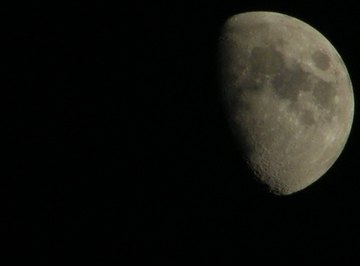
In astronomical terms, the word "transit" has three meanings, all connected with the apparent motion of celestial bodies from the vantage point of an observer. Because the sun and Earth’s moon are the largest celestial bodies as seen from Earth, their transits have particular significance and draw interest from astronomers and casual sky watchers alike.
Crossing the Meridian
The U.S. Naval Observatory defines transit as the instant a celestial body crosses an observer’s meridian, an imaginary line in the sky that runs from north to south. The sun’s transit, then, occurs precisely at noon, but not noon as defined by time zones. The observatory's website explains the sun's transit occurs at local solar noon, or noon as shown on a sundial. If you’re watching from low to middle latitudes on Earth, transit occurs approximately between sunrise and sunset, at the point where the sun is highest in the sky. It’s different, however, in the high latitudes near the North and South Poles. In the land of the midnight sun, there can be several transits between sunrise and sunset.
Lunar Noon
A moon transit carries the same definition of crossing the meridian but the instant of “lunar noon” varies across the day. The new moon, when the face seen from Earth is fully in the dark, transits at about the same time as the sun, solar noon. It's not precisely the same because of particulars of the moon’s orbit around the Earth. When the moon is in its first quarter, it transits about six hours after the sun. The full moon transits about 12 hours after solar noon, and the last-quarter moon crosses an observer’s meridian six hours before solar noon.
Crossing the Face
The European Southern Observatory's definition of transit focuses on a different celestial occurrence. Its website describes a transit as the appearance of an astronomical object crossing the face of a larger object. From Earth, with the use of indirect observation through a telescope or directly through a heavily filtered telescope, you can periodically see the planets Venus and Mercury cross the face of the sun. Some Earth-bound photographers have even captured silhouettes of the space shuttle and the International Space Station crossing the sun. Even a small telescope can capture the transits of Jupiter's moons as they cross the face of the gas giant.
Observers Beyond Earth
NASA’s solar observatory twin probes dubbed STEREO have gone far enough into space to capture the moon’s transit of the sun. The spacecraft captured the moon in a video as a dark disc racing across the sun's face. When the moon eclipses the sun as seen from Earth, it’s described as an occultation rather than a transit. An occultation occurs when an object in the sky obscures or completely blocks the view of another object.
Telescopic View
The third definition of transit describes the motion of an object as it crosses the field of vision of a stationary telescope. Generally, this refers to the apparent motion of stars as it transits through the sights of the telescope. But aim the telescope for the moon, and its transit can be quite dramatic as the observer seems to race across the lunar surface.
References
About the Author
Tom Chmielewski is a longtime journalist with experience in newspapers, magazines, books, e-books and the Internet. With his company TEC Publishing, he has published magazines and an award-winning multimedia e-book, "Celebration at the Sarayi." Chmielewski's design skills include expertise in Adobe Creative Suite's InDesign and Photoshop. He holds a Bachelor of Arts in English from Western Michigan University.
Photo Credits
moon image by Nikolay from Fotolia.com
